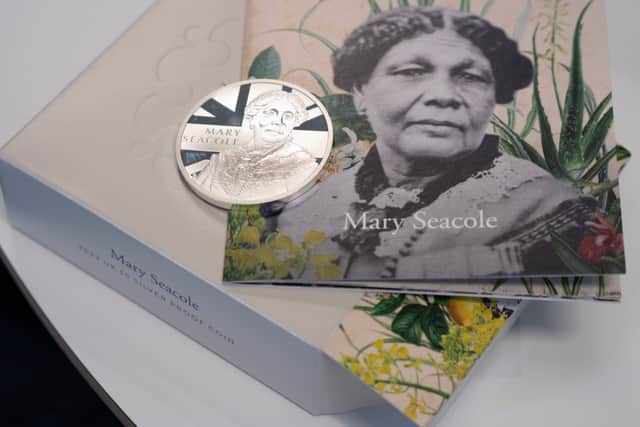What did Mary Seacole do? What was she famous for, facts, who is she - and Black History Month 2023 coin
This article contains affiliate links. We may earn a small commission on items purchased through this article, but that does not affect our editorial judgement.
and live on Freeview channel 276
The first named black woman from outside the UK to appear on a Royal Mint coin is a Jamaican who served as a nurse for British soldiers in the 19th century.
Mary Seacole, who had a Scottish father, overcame prejudice in her home country to care for soldiers who had been hurt in the Crimean War.
Advertisement
Hide AdAdvertisement
Hide AdHer commemorative coin was unveiled on Monday (2 October), seven years after a 12-year campaign that raised £500,000 to honour her with the first statue of a named black woman in the UK at St Thomas' Hospital in London.
Sculptor Martin Jennings, who designed the statue, also drew up the design for the coin’s obverse, which features King Charles. The £5 coin, which is not for legal tender, has been produced to “commemorate and celebrate” the women of Britain, a spokeswoman for the Mary Seacole Trust said.
Trevor Sterling, chair of Mary Seacole Trust, said: “This is another significant historical moment and it pays tribute to Mary Seacole as a symbol of the NHS, diversity, social justice and also in understanding the diverse contributions that have been made to this country.


“This is a very proud moment, and I’m looking forward to travelling to Jamaica to honour Mary Seacole Day to present the coin to the new Jamaican high commissioner and gift a coin to the Institute of Jamaica.
Advertisement
Hide AdAdvertisement
Hide Ad“It’s our way of saying thank you, we know that you suffered a loss as a result, and we acknowledge what’s been given to us.”
Who was Mary Seacole?
Mary Seacole was born in Jamaica in 1805 to a Scottish soldier and a Jamaican woman. She considered herself to be a Creole and faced civil rights limitations, including not being allowed to vote, hold public office or pursue a professional career.
In 1854, she travelled to England and requested to serve as an Army nurse in the Crimea, but her request was denied. Undeterred, she went to the Crimea anyway and established the British Hotel near Balaclava, offering comfortable accommodation for sick and recovering officers.
She provided food, medical care, and other support to wounded and sick soldiers, often using traditional Jamaican and herbal remedies that she had learned from her mother.
Advertisement
Hide AdAdvertisement
Hide AdHer hotel became a place where soldiers could receive comfort and care, and she became known for her kindness and dedication to their wellbeing. The nurse also risked gunfire on the front line to help gravely wounded soldiers, earning herself the nickname “Mother Seacole”.
Despite her contributions, Mary Seacole faced racial prejudice and discrimination during her time in Crimea. After the war, Seacole faced financial difficulties and returned to England in 1856. Unfortunately, she did not receive the recognition or financial support that she had hoped for her contributions during the war.
Despite her tireless efforts to provide care to wounded and sick soldiers, her contributions were overshadowed by Florence Nightingale, who is often more prominently associated with nursing during the Crimean War.
Following her return to England, Seacole faced financial hardships and struggled to make ends meet. To support herself, she published her memoir, titled 'Wonderful Adventures of Mrs. Seacole in Many Lands,' in 1857.
Advertisement
Hide AdAdvertisement
Hide AdThis memoir chronicled her life, experiences, and adventures in various parts of the world, including her time in Crimea.
In the years that followed, Mary Seacole continued to run her business ventures, which included catering and providing herbal remedies. She also remained active in various social and charitable activities. Despite facing challenges and financial setbacks, she remained a resilient and determined individual.
Where can I get the coin?
The coin is available in gold Proof, silver Proof, and silver Proof Piedfort. It can be purchased from royalmint.com.
Comment Guidelines
National World encourages reader discussion on our stories. User feedback, insights and back-and-forth exchanges add a rich layer of context to reporting. Please review our Community Guidelines before commenting.
